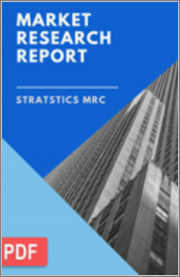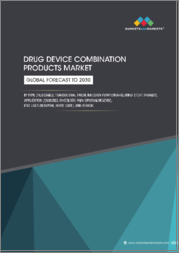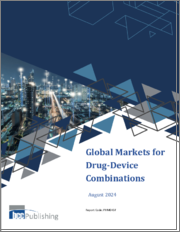
|
시장보고서
상품코드
1372023
세계 의약품-의료기기 조합 제품 시장 : 제품별, 용도별, 최종 사용자별, 지역별 분석(-2030년)Drug Device Combination Products Market Forecasts to 2030 - Global Analysis By Product, Application, End User and By Geography |
||||||
Stratistics MRC에 의하면, 세계 의약품-의료기기 조합 제품 시장은 2023년에 1,417억 달러를 차지하고, 예측 기간중의 복합 연간 성장률(CAGR) 10.9%를 나타낼 전망이며, 2030년에는 2,924억 달러에 이를 것으로 예측되고 있습니다.
의약품과 의료기기의 조합 제품은 화학적 또는 물리적 수단에 의해 의료기기와 의약품 활성 물질을 결합하여 단일 실체를 형성하는 의료기기입니다. 정확한 약물 전달, 국소 투여 및 맞춤형 치료를 통해 이러한 솔루션은 많은 질병의보다 안전하고 효율적인 관리 및 치료에 기여합니다. 약물 용출 스텐트, 주입 펌프, 흡입기, 경피 전달 시스템, prefilled 주사기 및 기타 일반적인 drug-device combo 제품 등이 그 예입니다.
IDF 2021에 따르면 약 5억 3,700만 명의 성인이 당뇨병을 앓고 있으며, 2030년에는 6억 4,300만 명, 2045년에는 7억 8,300만 명으로 증가할 것으로 예측됩니다.
제품 출시 증가
당뇨병, 암, 만성 호흡기 질환, 심혈관 질환 등 만성 질환의 유병률이 증가함에 따라 약물과 장치의 조합 제품 시장이 확대되고 있습니다. 예를 들어, 웨어러블 생체 센서 기술의 최고 혁신자인 Valencell은 2023년 1월에 출시되었습니다. Valencell은 다양한 용도를 위한 정확하고 신뢰할 수 있는 생리학적 모니터링을 전문으로 합니다. 만성 질환을 관리하는 솔루션을 시장에 투입하는 데 주력하기 위해 Valencell은 디지털 건강 산업에서 자체 브랜드 제품 라인을 개발할 계획을 발표했습니다.
제조상의 과제
의약품과 의료기기의 조합 제품에는 특정 장비 및 전문 지식이 필요한 복잡한 제조 절차가 있을 수 있습니다. 의약품과 의료기기의 통합에는 복잡한 조립, 품질 관리 및 무균 포장이 자주 요구됩니다. 그러나 적절한 제조 규범(GMP)과 품질 요구사항을 준수하는 것은 어렵고, 제조 비용 상승 및 공급망 문제를 일으킬 수 있습니다.
정부의 initiative
만성 질환의 부담 증가를 다루고 환자의 안전성을 높이기 위해 세계 정부가 다양한 프로그램을 시행하고 있습니다. 이러한 활동은 매우 중요하며, 그 결과 의약품과 의료기기의 조합 제품 세계 시장이 확대되고 있습니다. 예를 들어, 미국 FDA는 2021년 9월 의약품 개발에서 AI와 ML의 중요한 영향력을 인정했습니다. 올해 AI·ML을 구성요소로 하는 의약품 및 생물학적 제제의 신청은 100건을 넘었습니다. 신약, 임상 연구, 안전 모니터링, 제조 등 의약품 개발의 다양한 단계에서 AI와 ML이 활용되고 있습니다.
규제 장애
의약품과 의료기기의 조합 제품은 복잡한 규제 기준을 준수해야 합니다. 규제 당국의 라이선스를 취득하고 유럽 의약청(EMA)과 미국 식품의약국(FDA)을 포함한 다양한 규제 기관에 대한 규정 준수를 보장하는 데는 많은 시간과 비용이 소요됩니다. 하지만 제품 개발, 임상시험, 시장 진입 시 엄격한 규제와 변화하는 기준으로 인해 제조업체는 어려움을 겪을 수 있습니다.
COVID-19의 영향:
2019년 12월 COVID-19 바이러스 유행 이후 이 질병은 100개국 이상으로 확대되었으며 2020년 1월 30일에는 세계보건기구(WHO)가 공중보건 긴급사태로 선언했습니다. 그러나 의약품과 장치의 조합 제품 세계 시장은 COVID-19의 유행에 의해 큰 영향을 받고 있습니다. 시장은 호흡기 장치에 대한 수요가 증가하고 의약품과 장치의 조합에서 기술 혁신에 의해 형성되고 있습니다. 그러나 리소스 우선 순위 지정, 제조, 공급망 중단 등의 문제가 떠오르고 있습니다. 유행은 업계의 혁신과 협력을 자극했지만 장기적인 영향은 아직 보이지 않았습니다.
예측 기간 동안 경피 패치 분야가 최대가 될 전망입니다.
경피 패치 부문은 장기 치료가 필요한 질병에서 약물의자가 투여에 대한 수요가 증가함에 따라 예측 기간 동안 최대가 될 것으로 예상됩니다. 예를 들어, 당뇨병 환자는 인슐린의 빈번한 정맥 내 투여가 필요합니다. 또한 인슐린을 투여하기 위해 바늘을 자주 사용하는 것과 관련된 고통과 감염 위험이 증가하여 대체 약물 전달 방법의 필요성이 증가하고 있습니다.
예측 기간 동안 암 치료 분야의 복합 연간 성장률(CAGR)이 가장 높을 것으로 예상됩니다.
암 치료 분야는 예측 기간 중에 가장 높은 복합 연간 성장률(CAGR)이 예상됩니다. 치료 효과를 높이기 위해 약리학적 물질과 의료기기를 통합함으로써 이러한 제품은 암 치료의 특징적인 방법을 제공합니다. 이식 가능한 약물 전달 장치, 국소 방사선 요법, 표적 약물 전달의 사용이 가능합니다. 게다가 화학요법, 면역요법, 표적요법 등 다양한 치료법을 조합하여 시너지 효과와 맞춤형 치료 옵션을 제공합니다.
최대 점유율을 차지하는 지역:
아시아태평양은 인구가 많아 암과 같은 만성질환의 빈도가 상승하고 건강 관리 비용이 상승하고 있기 때문에 예측기간 동안 동 시장에서 가장 큰 점유율을 차지할 것으로 예상됩니다. 또한이 지역 시장은 필요한 용량의 적은 양, 약물의 정시 방출, 항 감염성 약물의 병용으로 인한 장치 중심의 직접적인 감염 완화, 전신 노출 감소와 같은 이러한 제품 장점에 대한 의사의 의식 증가의 결과를 나타낼 전망이며 있습니다.
복합 연간 성장률(CAGR)이 가장 높은 지역:
북미는 의약품과 장치의 조합 제품을 채택하고 지역의 확립된 건강 관리 인프라를 통해 예측 기간 동안 수익성 높은 성장을 이룰 것으로 예상됩니다. 게다가 많은 백신 및 기타 치료법들이 이러한 산업에서 나오기 때문에 기업이 제품의 연구 개발에 추가 자금을 투자함으로써 의약품과 의료기기의 조합 제품에 대한 수요가 확대될 가능성 높습니다.
무료 맞춤설정 서비스:
이 보고서를 구독하는 고객은 다음 무료 맞춤설정 옵션 중 하나를 사용할 수 있습니다.
- 기업 프로파일
- 추가 시장 기업의 종합적 프로파일링(3개사까지)
- 주요 기업의 SWOT 분석(3개사까지)
- 지역 세분화
- 고객의 관심에 응한 주요국 시장 추계,예측 및 복합 연간 성장률(CAGR)(주: 타당성 확인에 따름)
- 경쟁 벤치마킹
- 제품 포트폴리오, 지리적 존재, 전략적 제휴에 기반한 주요 기업 벤치마킹
목차
제1장 주요 요약
제2장 서문
- 개요
- 이해관계자
- 조사 범위
- 조사 방법
- 데이터 마이닝
- 데이터 분석
- 데이터 검증
- 조사 접근
- 조사 소스
- 1차 조사 소스
- 2차 조사 소스
- 전제조건
제3장 시장 동향 분석
- 소개
- 성장 촉진요인
- 억제요인
- 기회
- 위협
- 제품분석
- 용도 분석
- 최종 사용자 분석
- 신흥 시장
- COVID-19의 영향
제4장 Porter's Five Forces 분석
- 공급기업의 협상력
- 구매자의 협상력
- 대체품의 위협
- 신규 참가업체의 위협
- 경쟁 기업간 경쟁 관계
제5장 세계 의약품-의료기기 조합제품 시장 : 제품별
- 소개
- 주입 펌프
- 인슐린
- Implantable
- 주사기
- 외래
- 정형외과용 조합제품
- Antibiotic Bone Cement
- Bone Graft Implants
- 경피 패치
- 광선역학적 치료장치
- 약물 용출 스텐트
- 상처 관리 제품
- 항균 카테터
- 심혈관
- 비뇨기과
- 기타 제품
제6장 세계 의약품-의료기기 조합 제품 시장 : 용도별
- 소개
- 당뇨병
- 암 치료
- 호흡기 문제
- 기타 용도
제7장 세계 의약품-의료기기 조합 제품 시장 : 최종 사용자별
- 소개
- 가정치료 환경
- 외래수술센터(ASC)
- 병원 및 클리닉
- 기타 최종 사용자
제8장 세계 의약품-의료기기 조합제품 시장 : 지역별
- 소개
- 북미
- 미국
- 캐나다
- 멕시코
- 유럽
- 독일
- 영국
- 이탈리아
- 프랑스
- 스페인
- 기타 유럽
- 아시아태평양
- 일본
- 중국
- 인도
- 호주
- 뉴질랜드
- 한국
- 기타 아시아태평양
- 남미
- 아르헨티나
- 브라질
- 칠레
- 기타 남미
- 중동 및 아프리카
- 사우디아라비아
- 아랍에미리트(UAE)
- 카타르
- 남아프리카
- 기타 중동 및 아프리카
제9장 주요 발전
- 계약, 파트너십, 협업 및 합작투자(JV)
- 인수 및 합병
- 신제품 발매
- 사업 확대
- 기타 주요 전략
제10장 기업 프로파일
- Abbott Laboratories
- Allergan plc
- Boston Scientific Corporation
- CR Bard
- Medtronic Plc
- Mylan NV
- Novartis AG
- Stryker Corporation
- Teleflex Incorporated
- Terumo Corporation
- WL Gore & Associates, Inc.
According to Stratistics MRC, the Global Drug Device Combination Products Market is accounted for $141.7 billion in 2023 and is expected to reach $292.4 billion by 2030 growing at a CAGR of 10.9% during the forecast period. Drug-device combination products are medical devices that combine a device and active medicinal substances to form a "single entity" by chemical or physical means. Due to precise medication delivery, local administration, and customized treatment, these solutions contribute to the safer, more efficient management and treatment of a number of illnesses. Drug-eluting stents, infusion pumps, inhalers, transdermal delivery systems, prefilled syringes, and other popular drug-device combo products are instances.
According to the IDF 2021, approximately 537 million adults are living with diabetes, and the number of people adults living with diabetes is projected to rise to 643 million by 2030 and 783 million by 2045.
Market Dynamics:
Driver:
A rise in product launches
The market for drug-device combination products is expanding due to the increased prevalence of chronic diseases such as diabetes, cancer, chronic respiratory diseases, and cardiovascular diseases. For instance, Valencell, a top innovator in wearable biometric sensor technology, will be available in January 2023. Valencell specializes in accurate and dependable physiological monitoring for a variety of applications. In order to concentrate its efforts on bringing solutions to market to manage chronic conditions, Valencell has announced plans to develop its own branded product line in the digital health industry.
Restraint:
Manufacturing challenges
Drug device combination products might have complicated manufacturing procedures that require specific equipment and expertise. Complex assembly, quality control, and sterile packaging requirements are frequently required for the integration of pharmaceuticals and devices. However, it can be challenging to adhere to good manufacturing practices (GMP) and quality requirements, which can raise production costs and cause supply chain issues.
Opportunity:
Governmental initiatives
Various programs are being implemented by governments all over the world to address the growing burden of chronic diseases and advance patient safety. The global market for drug device combination products is expanding as a result of these activities, which are extremely important. For instance, the US FDA acknowledged the important influence of AI and ML in medicine development in September 2021. This year, there were over 100 medication and biologic submissions with AI/ML components. Various stages of drug development, such as drug discovery, clinical research, safety surveillance, and manufacturing, all make use of AI and ML.
Threat:
Regulatory obstacles
Drug device combination products must adhere to complicated regulatory standards. It can take a lot of time and money to obtain regulatory licenses and ensure compliance with different regulatory organizations, including the European Medicines Agency (EMA) and the U.S. Food and Drug Administration (FDA). However, manufacturers may have difficulties when it comes to product development, clinical studies, and market access due to strict restrictions and changing standards.
COVID-19 Impact:
The disease has expanded to over 100 nations since the COVID-19 viral epidemic in December 2019, and on January 30, 2020, the World Health Organization proclaimed it a public health emergency. However, the global market for medicine-device combination products has been significantly impacted by the COVID-19 epidemic. The market is shaped by rising demand for respiratory devices and innovations in drug-device combinations. However, issues with resource prioritization, manufacturing, and supply chain interruptions have emerged. The pandemic has stimulated industry innovation and cooperation, but the long-term effects are still being witnessed.
The transdermal patches segment is expected to be the largest during the forecast period
The segment for transdermal patches is anticipated to be the largest over the course of the projection period due to the rising demand for drug self-administration in conditions where diseases demand long-term therapy. For instance, a patient with diabetes requires frequent intravenous administration of insulin. Additionally, the need for alternative drug delivery methods is growing due to the pain and increased risk of infection associated with the frequent use of needles to deliver insulin.
The cancer treatment segment is expected to have the highest CAGR during the forecast period
Cancer Treatment segment is expected to have the highest CAGR during the forecast period. By integrating pharmacological substances and medical devices to enhance treatment outcomes, these products offer a distinctive method of cancer therapy. They make it possible to use implantable medication delivery devices, localized radiation therapy, and targeted drug delivery. Additionally, these medications offer synergistic effects and individualized treatment options by combining various therapeutic methods, including chemotherapy, immunotherapy, and targeted therapy.
Region with largest share:
Due to the region's vast population, rising frequency of chronic diseases like cancer, and rising healthcare costs, the Asia-Pacific region is anticipated to hold the largest share of the market during the projected period. Moreover, the regional market is growing as a result of increasing physician awareness of the benefits of these products, which include low dosage requirements, timed medication release, direct device-centered infection mitigation using anti-infective medication in combination, and reduced systemic exposure.
Region with highest CAGR:
Owing to the adoption of drug-device combination products along with the region's well-established healthcare infrastructure, North America is predicted to have profitable growth over the course of the projection period. Additionally, since many vaccines and other treatments are generated by these industries, there is likely to be a growth in demand for drug-device combination products as corporations invest additional funds in product research and development.
Key players in the market:
Some of the key players in Drug Device Combination Products Market include: Abbott Laboratories, Allergan plc, Boston Scientific Corporation, C.R. Bard, Medtronic Plc, Mylan N.V., Novartis AG, Stryker Corporation, Teleflex Incorporated, Terumo Corporation and W. L. Gore & Associates, Inc.
Key Developments:
In August 2022, Terumo Corporation launched G-Lasta Subcutaneous Injection 3.6 mg BodyPod", a drug-device combination product co-developed with Kyowa Kirin Co., Ltd. The product received approval from Japan's Ministry of Health, Labour, and Welfare (MHLW).
In June 2022, Novartis acquired Kedalion Therapeutics and its AcuStream technology that facilitate precise dosing and accurate delivery of certain topical ophthalmic medications to the eye. The acquisition enhances the Novartis ophthalmics portfolio, advancing efforts to investigate transformative ophthalmic methods to address unmet patient needs in front-of-eye conditions.
Products Covered:
- Infusion Pumps
- Orthopedic Combination Products
- Transdermal Patches
- Photodynamic Therapy Devices
- Drug Eluting Stents
- Wound Care Products
- Antimicrobial Catheters
- Other Products
Applications Covered:
- Diabetes
- Cancer Treatment
- Respiratory Problems
- Other Applications
End Users Covered:
- Home Care Settings
- Ambulatory Surgery Centers
- Hospitals & Clinics
- Other End Users
Regions Covered:
- North America
- US
- Canada
- Mexico
- Europe
- Germany
- UK
- Italy
- France
- Spain
- Rest of Europe
- Asia Pacific
- Japan
- China
- India
- Australia
- New Zealand
- South Korea
- Rest of Asia Pacific
- South America
- Argentina
- Brazil
- Chile
- Rest of South America
- Middle East & Africa
- Saudi Arabia
- UAE
- Qatar
- South Africa
- Rest of Middle East & Africa
What our report offers:
- Market share assessments for the regional and country-level segments
- Strategic recommendations for the new entrants
- Covers Market data for the years 2021, 2022, 2023, 2026, and 2030
- Market Trends (Drivers, Constraints, Opportunities, Threats, Challenges, Investment Opportunities, and recommendations)
- Strategic recommendations in key business segments based on the market estimations
- Competitive landscaping mapping the key common trends
- Company profiling with detailed strategies, financials, and recent developments
- Supply chain trends mapping the latest technological advancements
Free Customization Offerings:
All the customers of this report will be entitled to receive one of the following free customization options:
- Company Profiling
- Comprehensive profiling of additional market players (up to 3)
- SWOT Analysis of key players (up to 3)
- Regional Segmentation
- Market estimations, Forecasts and CAGR of any prominent country as per the client's interest (Note: Depends on feasibility check)
- Competitive Benchmarking
- Benchmarking of key players based on product portfolio, geographical presence, and strategic alliances
Table of Contents
1 Executive Summary
2 Preface
- 2.1 Abstract
- 2.2 Stake Holders
- 2.3 Research Scope
- 2.4 Research Methodology
- 2.4.1 Data Mining
- 2.4.2 Data Analysis
- 2.4.3 Data Validation
- 2.4.4 Research Approach
- 2.5 Research Sources
- 2.5.1 Primary Research Sources
- 2.5.2 Secondary Research Sources
- 2.5.3 Assumptions
3 Market Trend Analysis
- 3.1 Introduction
- 3.2 Drivers
- 3.3 Restraints
- 3.4 Opportunities
- 3.5 Threats
- 3.6 Product Analysis
- 3.7 Application Analysis
- 3.8 End User Analysis
- 3.9 Emerging Markets
- 3.10 Impact of Covid-19
4 Porters Five Force Analysis
- 4.1 Bargaining power of suppliers
- 4.2 Bargaining power of buyers
- 4.3 Threat of substitutes
- 4.4 Threat of new entrants
- 4.5 Competitive rivalry
5 Global Drug Device Combination Products Market, By Product
- 5.1 Introduction
- 5.2 Infusion Pumps
- 5.2.1 Insulin
- 5.2.2 Implantable
- 5.2.3 Syringe
- 5.2.4 Ambulatory
- 5.3 Orthopedic Combination Products
- 5.3.1 Antibiotic Bone Cement
- 5.3.2 Bone Graft Implants
- 5.4 Transdermal Patches
- 5.5 Photodynamic Therapy Devices
- 5.6 Drug Eluting Stents
- 5.7 Wound Care Products
- 5.8 Antimicrobial Catheters
- 5.8.1 Cardiovascular
- 5.8.2 Urological
- 5.9 Other Products
6 Global Drug Device Combination Products Market, By Application
- 6.1 Introduction
- 6.2 Diabetes
- 6.3 Cancer Treatment
- 6.4 Respiratory Problems
- 6.5 Other Applications
7 Global Drug Device Combination Products Market, By End User
- 7.1 Introduction
- 7.2 Home Care Settings
- 7.3 Ambulatory Surgery Centers
- 7.4 Hospitals & Clinics
- 7.5 Other End Users
8 Global Drug Device Combination Products Market, By Geography
- 8.1 Introduction
- 8.2 North America
- 8.2.1 US
- 8.2.2 Canada
- 8.2.3 Mexico
- 8.3 Europe
- 8.3.1 Germany
- 8.3.2 UK
- 8.3.3 Italy
- 8.3.4 France
- 8.3.5 Spain
- 8.3.6 Rest of Europe
- 8.4 Asia Pacific
- 8.4.1 Japan
- 8.4.2 China
- 8.4.3 India
- 8.4.4 Australia
- 8.4.5 New Zealand
- 8.4.6 South Korea
- 8.4.7 Rest of Asia Pacific
- 8.5 South America
- 8.5.1 Argentina
- 8.5.2 Brazil
- 8.5.3 Chile
- 8.5.4 Rest of South America
- 8.6 Middle East & Africa
- 8.6.1 Saudi Arabia
- 8.6.2 UAE
- 8.6.3 Qatar
- 8.6.4 South Africa
- 8.6.5 Rest of Middle East & Africa
9 Key Developments
- 9.1 Agreements, Partnerships, Collaborations and Joint Ventures
- 9.2 Acquisitions & Mergers
- 9.3 New Product Launch
- 9.4 Expansions
- 9.5 Other Key Strategies
10 Company Profiling
- 10.1 Abbott Laboratories
- 10.2 Allergan plc
- 10.3 Boston Scientific Corporation
- 10.4 C.R. Bard
- 10.5 Medtronic Plc
- 10.6 Mylan N.V.
- 10.7 Novartis AG
- 10.8 Stryker Corporation
- 10.9 Teleflex Incorporated
- 10.10 Terumo Corporation
- 10.11 W. L. Gore & Associates, Inc.



















